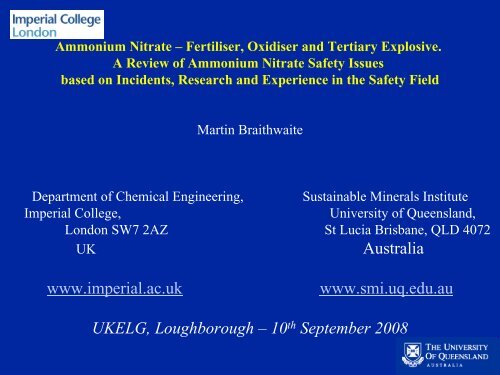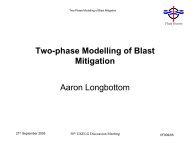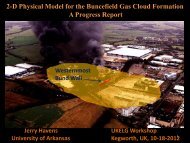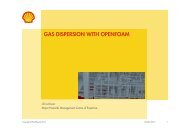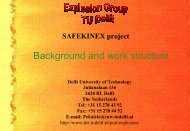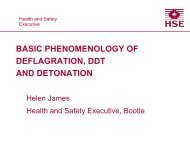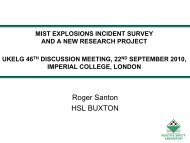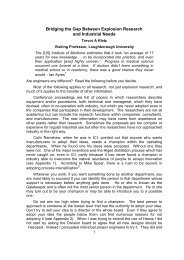A review of - ukelg
A review of - ukelg
A review of - ukelg
Create successful ePaper yourself
Turn your PDF publications into a flip-book with our unique Google optimized e-Paper software.
Ammonium Nitrate – Fertiliser, Oxidiser and Tertiary Explosive.A Review <strong>of</strong> Ammonium Nitrate Safety Issuesbased on Incidents, Research and Experience in the Safety FieldMartin BraithwaiteDepartment <strong>of</strong> Chemical Engineering, Sustainable Minerals InstituteImperial College,University <strong>of</strong> Queensland,London SW7 2AZ St Lucia Brisbane, QLD 4072UKAustraliawww.imperial.ac.ukwww.smi.uq.edu.auUKELG, Loughborough – 10 th September 2008
o Governmental Regulations – Storage and Transporto Safe Process Operationo Threat from “Improvised” explosiveso Recent incidentso Debate around testing <strong>of</strong> ANo Novel productso Increased use <strong>of</strong> AN based explosives (Chinese economy)
Ammonium NitrateHygroscopic solid and oxidant, Melting Point 169 deg C“stable”unless contaminants present– eg organic species, metallic & other fuels, halides, pHKnown and characterised tertiary explosive
Ammonium Nitrate decomposition chemistry (simplified)Reversible endothermic disssociation( ) ( ) ( )NH NO s = NH g + HNO g - ΔH=186 kJ/mole AN4 3 3 3followed by a number <strong>of</strong> irreversible exothermic reactions at higher temperature e.g.( ) = ( ) + 2 ( )NH NO s N O g H O g4 3 2 2- ΔH=-37 kJ/mole AN( ) ( ) ( ) ( )2NH NO s = 2N g + 4 H O g + O g - ΔH=-118 kJ/mole AN4 3 2 2 2
StorageOctober, 1918 Morgan, New JerseyOne <strong>of</strong> the shells released from a shell loading plant explosion caused a large explosion in AN store,but the majority <strong>of</strong> the ammonium nitrate did not detonate.1963 Holland – No Injury4000 tonnes <strong>of</strong> NPK in storage involved in self-sustained decomposition.1966 USA – No injuryA fire involving AN fertiliser and other combustibles lead to an explosion1973 USA – No injuryA fire in an AN wooden store resulted in the explosion <strong>of</strong> a few tonnes <strong>of</strong> AN.14,000 tonnes were unaffected.1975 Germany – No injurySelf sustained decomposition in NPK fertiliser initiated by welding resulted in evacuation <strong>of</strong> 1000 residents.1978 USA – No injury500 tonnes <strong>of</strong> AN involved in a warehouse fire – no explosion1982 UK – No injuryMajor fire with wooden furniture stored near AN fertiliser.Resulted in a deflagration and toxic fume release. Local evacuation undertaken.
Storage contd1987 France –– No injurySelf sustained decomposition in 1450 tonnes NPK fertliser.Mass evacuation due to toxic fume release but bulk AN not affected1978 Yugoslavia – No injurySelf sustained decomposition in 17,000 tonnes <strong>of</strong> bulk NPK fertiliser.Mass evacuation necessary.1998 Kentucky, USAA warehouse containing 4000 tonnes <strong>of</strong> AN in basement was allowed to burn out.Two explosions reported from propane cylinders stored there. Mass evacuationtook place.September 21st, 2001 AZF Fertilizer Toulouse France 31 fatalities, 350injuriesThe explosion had occurred in a warehouse in which granular ammonium nitratewas stored flat, separated by partitions. The amount is said to be between 200 to300 tonnes <strong>of</strong> ammonium nitrate, which is used to make fertilisers. A spokesmanfor the Interior Ministry in Paris ruled out a criminal attack, saying the explosionhad been caused by an accident following an "incident in the handling <strong>of</strong>products". The exact cause remains unknown in public domain – contamination ?.
DisaggregationJuly, 1921 Kriewald Germany (Poland) - 19 fatalitiesWorkers tried to dislodge 30 tonnes <strong>of</strong> ammonium nitrate which had aggregatedin two wagons when blasting explosives were used the wagons exploded.September 1921 Oppau, Germany – 450 fatalitiesThe fertilizer was a 50:50 mixture <strong>of</strong> ammonium nitrate & ammonium sulphate& the factory had used dynamite to disaggregate over 20,000 times withoutincident. It is thought that poor mixing had led to certain parts <strong>of</strong> the massto contain more ammonium nitrate than others. Only 450 tonnes exploded,out <strong>of</strong> 4500 tonnes <strong>of</strong> fertilizer stored in the warehouse.April 1942, Tessenderlo, Belgium - several hundred fatalitiesAn attempt to disaggregate a pile <strong>of</strong> 150 tonnes <strong>of</strong> ammonium nitratewith industrial explosives ended tragically.
TransportApril 1947, Texas City, United States - several hundred fatalitiesA cargo ship was being loaded when a fire was detected in the hold:2600 tonnes <strong>of</strong> AN in sacks were already aboard. The captain respondedby closing the hold and pumping in pressurised steam. An hour later,the ship exploded and set fire to another vessel, 250 metres away andcontained 1050 tonnes <strong>of</strong> sulphur and 960 tons <strong>of</strong> AN:this exploded the next day.July 1947, Brest, France – 29 fatalitiesA cargo ship was loaded with 3300 tonnes <strong>of</strong> AN & variousinflammable products when it caught fire. The vessel was towed out<strong>of</strong> the harbour and exploded.1954, Red Sea – No InjuryA fire in a ships hold containing AN, paper & organics/ copper resultedin an explosion. The ship was abandoned.1960, 1963 Traskwood, USA – No InjuryWagons were derailed with AN, nitric acid & hydrocarbons involvedin a fire & explosion.
Transport contd1965 Atlantic – 3 drowned4000 tonnes <strong>of</strong> NPK in bulk storage in self-sustained decomposition.1967 USA – No injuryA fire involving 50 tonnes <strong>of</strong> AN in paper bags in wagonswith wooden interior was allowed to burn out.1972 France – 2 fatalitiesDecomposition <strong>of</strong> lagging contaminated with AN & organicslead to an explosion. and release <strong>of</strong> hot AN solution.1972 Australia – 3 fatalitiesA fire in a semi-trailer with low density AN & oil lead to an explosion.1997 Brazil - several fatalitiesAN truck fire compounded by fire in petrol tanker trying to pass.A detonation was thought to have been initiated by an exploding propane bottle.Fatalities were largely in a parked coach near to the fire.2000 Florida, USA – one fatalityCollision between an AN truck and gasoline tanker resulted in a fire.(Fatality due to collision).
Process related1994 Terra, Port Neal, US – AN neutraliserIn a 1994 accident, AN solution (about 70 tonnes <strong>of</strong> AN) explodedduring a manufacturing process, causing a number <strong>of</strong> deaths and injuries.During a procedure to shut down the process, compressed airwas applied to the nitric acid line into the neutralizer, followed bypressurized steam at 200 psig and temperatures up to 220 deg C.After the steam had passed through the nitric acid line for several hours,the ammonium nitrate exploded in the neutralizer.The solution was highly acidic and was contaminated by chlorides.
Dust Explosions in AirAN is basically an oxidant.It has no measureable dust explosion characteristicse.g. minimum ignition energy, minimum ignition temperature, KST etc.
Deflagration and Minimum Burning PressuresDeflagration – steady state burn <strong>of</strong> condensed phase media– pressure dependent with defined cut-<strong>of</strong>f pressure (MBP)– molten liquid – fizz zone – steep thermal gradients.A number <strong>of</strong> studies have been carried out on AN and various additives& stable deflagration <strong>of</strong> pure solid AN has not been observed < 0.1 GPaThe presence <strong>of</strong> a halide salt or fuel can reduce this threshold pressureby a factor <strong>of</strong> 100 e.g. to 10 bara. Molten AN exhibits a lower MBP also
Thermal Explosion/ Reaction runawayNear simultaneous exothermic reaction - small thermal gradients.For pure AN, with endothermic & exothermic reaction pathways,onset temperatures for thermal explosion are high, ie ~ MPt.This onset temperature can, however, be dramatically reducedby the presence <strong>of</strong> a fuel or catalyst for thermal decomposition.
Detonation, Shock to Detonation- AN as a tertiary explosiveDiameter > critical diameter (density, particle characteristics, confinement)Shock Stimulus > shock pressure & critical area normally requiring donor charge
TNT Equivalence <strong>of</strong> pure Ammonium Nitrate solid• assuming 100 % efficiency• chemical equilibrium• adiabaticity• ideal detonation (Chapman Jouguet)
Approach taken• commercially available ideal detonation computer program• best fluid EoS• with/ without water condensation• range <strong>of</strong> AN initial densitiesConservative estimateSolves water condensation issueFinite rate phenomena not incorporated here
Ideal Detonation ModelIn an idealized model <strong>of</strong> detonation, explosive performance is dependant on• equilibrium thermodynamics <strong>of</strong> detonation products(fluid and solid phases)• initial density <strong>of</strong> the explosives• heat <strong>of</strong> formation <strong>of</strong> the explosiveShock WaveDetonationProductsReactionZoneDUnreactedExplosivePTSimple ZNDModel <strong>of</strong> Detonation
ZND Detonation and Rarefactionp or rCJvon NeumannspikeTaylorwaveSonicPlaneqDlReaction zonex
Ideal Detonation Computer Programs•EoS (fluid/ solid) - inter/ intra molecular contributions•Chemical Equilibrium Algorithm•Calculation Options•Databasesingredient explosivesproduct thermodynamics•Windows/ GUI etc
Ideal Detonation Codes EoSFundamental – WCA or similar –CHEQ, IDeX, Cheetah, TDSBased on statistical mechanics – hard sphere perturbation theoryParameters from other sourcesWell behaved higher derivativesGood match ALL experimental dataMore sophisticatedcalculationSome remaininguncertainties
6000Pressure, GPa604020ExptlWCA EoSJCZ3 EoSBKW EoSTemperature, K5000400030002000ExptlExptlWCA EoSJCZ3 EoSBKW EoS0.40 0.45 0.50 0.55 0.60Reduced Volume, V/Vcj100020 40 60 80Pressure, GPaWater Hugoniot: shock pressureWater Hugoniot: shock temperature
Adiabatic Gamma plots3Adiabatic Gamma2WCA EoSJCZ3 EoSJWL EoSBKW EoS12 4 6 8 10Reduced Volume, V/Vcj
AN TNT Equivalency =Thermodynamic TNT equivalencex Efficiency Factor
AN TNT Equivalence – Disparity in Estimates• some results are based on explosion and not detonation state data• assumptions regarding the composition <strong>of</strong> detonation products• different (less accurate) equations <strong>of</strong> state• different ammonium nitrate densities• inclusion <strong>of</strong> heat loss and/or kinetic energy• combining efficiency and TNT equivalence in one datum
AN Bases <strong>of</strong> Safety• AVOID – contamination, shock and sources <strong>of</strong> heat >170 deg C• MITIGATE – compartmentalise hazards to avoid single eventbarriers between inventories, shock absorbers, deflectors• PROCEDURAL – site security, surveillance• ELIMINATE – inventories less than critical massTNT Equivalence/ separation distances –uncertaintiesambiguitiesoverly conservativenot economicMore holistic safety approach desirable.
Pure ammonium nitrate(i) it cannot form an explosible dust in air(ii) it does not deflagrate until comparatively high pressureseg (~ 0.1 GPa) are reached(iii) it is thermally stable, even in an adiabatic environmentuntil temperatures >> ambient conditions eg ~ MPt(iv) Detonation (pure solid AN) requires large shock stimulusand large diameter/ confinementConcern is contamination, accidental or deliberate.


